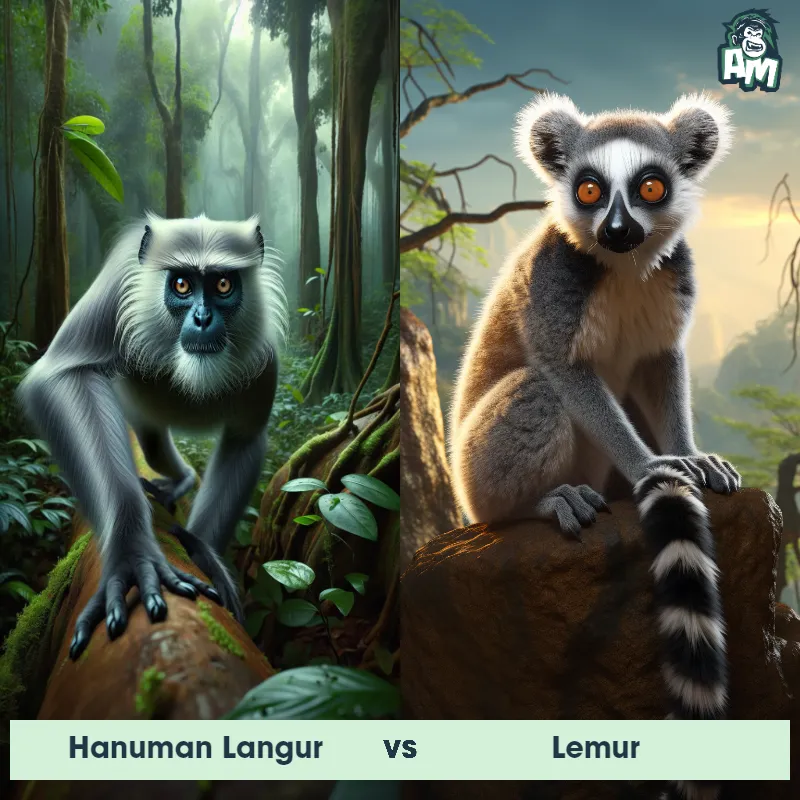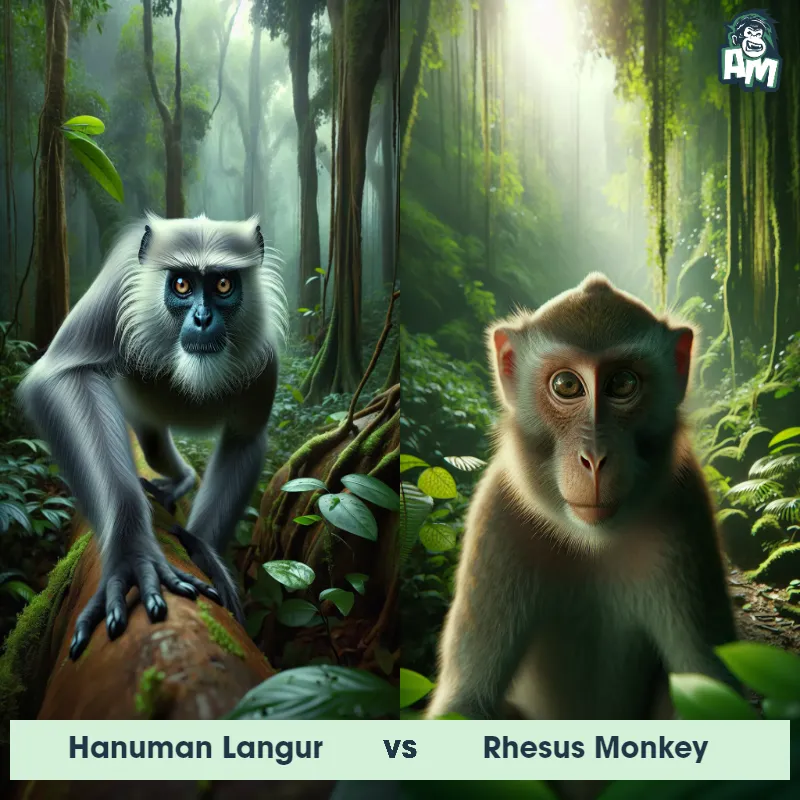The Hanuman Langur
The Hanuman Langur, also known as the Gray Langur, is a medium-sized primate found in South Asia. They have a robust built body with a long tail which helps in balancing while jumping and climbing. Their fur color varies from gray to brown, and they have a black face with prominent cheek flanges. Known for their keen intelligence, Hanuman Langurs are highly adaptable and are often found in diverse habitats like forests, grasslands, and urban areas. They primarily feed on leaves, fruits, and flowers, and live in groups called troops.

| Hanuman Langur | |
|---|---|
| Size | 2 to 3 feet (0.6 to 0.9 meters) |
| Weight | 33 to 44 pounds (15 to 20 kilograms) |
| Speed | 20mph (32km/h) |
| Key Strength | Agility and climbing skills |
| Biggest Weakness | Lack of physical aggression |
| Scientific Name | Semnopithecus entellus |
| Family | Cercopithecidae |
| Habitat | Forests, grasslands, and urban areas |
| Geography | Indian subcontinent |
| Diet | Herbivorous - mainly leaves, fruits, and flowers |
| Lifespan | 12 years - 15 years |

The Hanuman Langur
The Hanuman Langur, also known as the Gray Langur, is a medium-sized primate found in South Asia. They have a robust built body with a long tail which helps in balancing while jumping and climbing. Their fur color varies from gray to brown, and they have a black face with prominent cheek flanges. Known for their keen intelligence, Hanuman Langurs are highly adaptable and are often found in diverse habitats like forests, grasslands, and urban areas. They primarily feed on leaves, fruits, and flowers, and live in groups called troops.
Fun Fact: Hanuman Langurs are considered sacred animals in Hindu mythology and are often associated with the deity Hanuman, known for his bravery and devotion in the Hindu epic, Ramayana.
| Hanuman Langur | |
|---|---|
| Size | 2 to 3 feet (0.6 to 0.9 meters) |
| Weight | 33 to 44 pounds (15 to 20 kilograms) |
| Speed | 20mph (32km/h) |
| Key Strength | Agility and climbing skills |
| Biggest Weakness | Lack of physical aggression |
| Scientific Name | Semnopithecus entellus |
| Family | Cercopithecidae |
| Habitat | Forests, grasslands, and urban areas |
| Geography | Indian subcontinent |
| Diet | Herbivorous - mainly leaves, fruits, and flowers |
| Lifespan | 12 years - 15 years |
Hanuman Langur Matchups
We use AI to simulate matchups between the Hanuman Langur and other animals. Our simulation considers size, strength, and natural predatory behaviors to determine the most likely outcome.

Can't find the Matchup you want?
Create Your Own MatchupHanuman Langur: Diet, Predators, Aggression, and Defensive Behaviors
What do Hanuman Langurs eat?
Hanuman Langurs are primarily herbivores, feeding on a diet consisting mainly of leaves, fruit, flowers, seeds, and insects. They are known to be adaptive eaters, consuming a variety of plant species depending on the availability of food in their habitat.
Do Hanuman Langurs have any predators?
Although adult Hanuman Langurs do not have many natural predators due to their large size and strength, they can sometimes fall prey to big cats such as leopards and tigers. Additionally, their infants are particularly vulnerable to birds of prey and larger carnivores.
Are Hanuman Langurs aggressive?
Hanuman Langurs are generally peaceful animals, but they can exhibit aggressive behavior in certain situations. Male langurs may become territorial and display aggression towards other males during mating season or when defending their group from threats.
Do Hanuman Langurs fight?
While conflicts between male Hanuman Langurs can escalate into physical fights, these situations are typically rare and are primarily centered around competition for mating rights or disputes over territory. Most interactions between individuals within a group are peaceful and involve social grooming and bonding.
How do Hanuman Langurs defend themselves?
Hanuman Langurs have developed various defense mechanisms to protect themselves from threats. They often rely on their agility and speed to escape danger, as well as their strength to intimidate predators. In group settings, they may also use vocalizations and posturing to communicate and deter potential threats.
What is the biggest weakness of Hanuman Langurs in a fight?
Despite their formidable size and strength, Hanuman Langurs' biggest weakness in a fight is their vulnerability when separated from their group. When isolated, they lose the protection and support of their companions, making them more susceptible to attacks from predators or rival males.
Fun Fact: Hanuman Langurs have a sophisticated social structure where the dominant males lead the troop and protect their members. They are known for their territorial behavior and will fiercely defend their group against intruders.
Fun Fact: In courtship displays, male Hanuman Langurs engage in a unique behavior called "staring contests," where they lock eyes with each other and try to intimidate their opponents. This behavior helps establish dominance and resolve conflicts within the troop.












